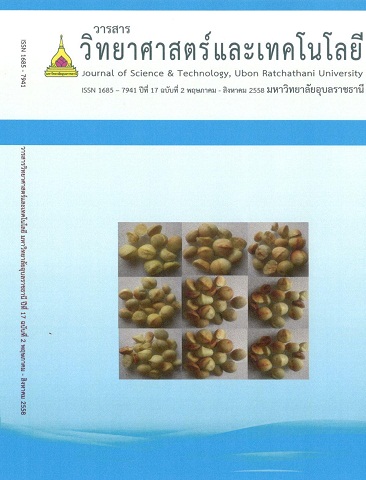Evaluation of a Pharmaceutical Care Program with Pregnant Women with Iron Deficiency Anemia
Main Article Content
บทคัดย่อ
Anemia is a major public health problem in Thailand. In pregnant women, it results from iron deficiency and is associated with increased risks of maternal and fetal mortality and morbidity and intrauterine growth retardation. The aim of this quasi-experimental study was to evaluate the effects of a pharmaceutical care program with pregnant women with iron deficiency anemia at the ante-natal clinic at Kaengkhoi Hospital, Saraburi, Thailand. The participants were recruited and enrolled by specific criteria, gave informed consent based on the hospital ethics committee agreement, and were assigned into two groups of 27, an experimental group and a comparison group. Both groups received health education provided by the routine system but the experimental group also attended a pharmaceutical care program three times throughout the study. The program focussed on: participants’ knowledge of iron deficiency anemia in pregnant women; compliance of pregnant women regarding iron supplementation; and levels of hematocrit (Hct). Data analysis was performed by SPSS V11.5. Results showed that 3 months after implementation of the program, the experimental group had average scores of knowledge significantly higher than those of the control group (7.48±2.40 vs. 4.63±2.35, p = 0.000). The compliance of pregnant women regarding iron supplementation in the experimental group was also significantly higher than the control group (2.34±1.37 vs. 3.33±1.4, p = 0.004). During the 3 month period, there were significant increases in Hct levels in the experimental group (31.79±1.46, 32.31±2.27, 33.04±2.73%, p = 0.028), whereas there were no significant increases in the control group (31.43±1.99, 31.52±2.33, 32.08±2.68%, p=0.178). Although Hct levels between the experimental group and the control group were not significantly different (33.04±2.73% vs. 32.08±2.68%, p=0.188), only the experimental group showed greater Hct levels based on the WHO criterion (Hct≥33%). In conclusion, this study demonstrated that the implemented pharmaceutical care program can be used as a guideline to increase the knowledge and compliance, and thus the Hct levels, in pregnant women with iron deficiency anemia.
ภาวะโลหิตจางเป็นปัญหาสาธารณสุขที่สำคัญของประเทศไทย โดยเฉพาะอย่างยิ่งภาวะโลหิตจางที่มีสาเหตุมาจากการขาดธาตุเหล็กในหญิงตั้งครรภ์ มีส่วนสำคัญที่ทำให้เพิ่มอัตราการป่วยและอัตราการเสียชีวิตของทั้งมารดาและทารก รวมทั้งส่งผลให้เกิดการเจริญเติบโตของทารกในครรภ์ช้า การศึกษานี้เป็นงานวิจัยกึ่งทดลอง (Quasi-experimental study) มีวัตถุประสงค์เพื่อศึกษาผลของการบริบาลทางเภสัชกรรมในหญิงตั้งครรภ์ที่มีภาวะโลหิตจางจากการขาดธาตุเหล็ก คลินิกฝากครรภ์ โรงพยาบาลแก่งคอย จังหวัดสระบุรี กลุ่มตัวอย่างเป็นหญิงตั้งครรภ์ที่มีคุณลักษณะตามที่กำหนดไว้และลงชื่อยินยอมการเข้าร่วมโครงการวิจัยตามรูปแบบของคณะกรรมการจริยธรรมของโรงพยาบาล แบ่งออกเป็นกลุ่มทดลองและกลุ่มควบคุมจำนวนกลุ่มละ 27 คน ทั้งกลุ่มทดลองและกลุ่มควบคุมจะได้รับคาแนะนำปกติจากคลินิกฝากครรภ์ แต่กลุ่มทดลองจะได้รับการบริบาลทางเภสัชกรรมจานวน 3 ครั้งตลอดการวิจัย การศึกษานี้จะเปรียบเทียบผลการให้บริบาลทางเภสัชกรรมในหัวข้อความรู้เรื่องภาวะโลหิตจางจากการขาดธาตุเหล็กในหญิงตั้งครรภ์ ความร่วมมือในการกินยาเม็ดธาตุเหล็ก และ ระดับค่าฮีมาโตคริต ทาการวิเคราะห์ข้อมูลโดยใช้โปรแกรมสำเร็จรูป SPSS V 11.5
ผลการวิจัยพบว่าเมื่อสิ้นสุดการบริบาลทางเภสัชกรรมหญิงตั้งครรภ์ในกลุ่มทดลองมีคะแนนเฉลี่ยความรู้สูงกว่ากลุ่มควบคุมอย่างมีนัยสำคัญทางสถิติ (7.48 ± 2.40 และ 4.63 ± 2.35 คะแนนตามลาดับ, p = 0.000) ความร่วมมือในการกินยาเม็ดธาตุเหล็กหลังให้การบริบาลทางเภสัชกรรมของหญิงตั้งครรภ์กลุ่มทดลองสูงกว่ากลุ่มควบคุมอย่างมีนัยสำคัญทางสถิติ (2.34±1.37 และ 3.33±1.45 คะแนนตามลำดับ, p = 0.04 โดยคะแนนสูงบ่งชี้ว่ามีความร่วมมือในการกินยาลดลง) หลังการบริบาลทางเภสัชกรรมพบว่า ค่าเฉลี่ยฮีมาโตคริตของหญิงตั้งครรภ์ในกลุ่มทดลองเพิ่มขึ้นอย่างมีนัยสำคัญทางสถิติ (31.79 ± 1.46, 32.31 ± 2.27 และ 33.04 ± 2.73% ตามลาดับ, p = 0.028) ส่วนในกลุ่มควบคุมพบว่าค่าเฉลี่ยฮีมาโตคริตไม่มีความแตกต่างกัน (31.43 ± 1.99, 31.52 ± 2.33 และ 32.08 ± 2.68, p = 0.178) ถึงแม้ว่าค่าเฉลี่ยฮีมาโตคริตหลังการบริบาลทางเภสัชกรรมเปรียบเทียบระหว่างกลุ่มทดลองและกลุ่มควบคุมจะไม่มีความแตกต่างกัน (33.04 ± 2.73 และ 32.08 ± 2.68%, p = 0.188) แต่เมื่อวิเคราะห์ข้อมูลเพื่อเปรียบเทียบค่าเฉลี่ยระดับฮีมาโตคริตหลังการทดลองกับเกณฑ์ระดับฮีมาโตคริตเป้าหมาย พบว่า หญิงตั้งครรภ์ในกลุ่มทดลองเท่านั้น มีค่าเฉลี่ยระดับฮีมาโตคริตมากกว่าหรือเท่ากับ 33% ที่ระดับนัยสำคัญ 0.05 ผลการวิจัยนี้แสดงให้เห็นว่า การบริบาลทางเภสัชกรรมสามารถเพิ่มความรู้เกี่ยวกับภาวะโลหิตจางจากการขาดธาตุเหล็กในหญิงตั้งครรภ์ เพิ่มความร่วมมือในการกินยาเม็ดธาตุเหล็กทาให้หญิงตั้งครรภ์สามารถแก้ไขภาวะโลหิตจางจากการขาดธาตุเหล็กได้
Article Details
บทความที่ได้รับการตีพิมพ์เป็นลิขสิทธิ์ของ วารสารวิทยาศาสตร์และเทคโนโลยี มหาวิทยาลัยอุบลราชธานี
ข้อความที่ปรากฏในบทความแต่ละเรื่องในวารสารวิชาการเล่มนี้เป็นความคิดเห็นส่วนตัวของผู้เขียนแต่ละท่านไม่เกี่ยวข้องกับมหาวิทยาลัยอุบลราชธานี และคณาจารย์ท่านอื่นๆในมหาวิทยาลัยฯ แต่อย่างใด ความรับผิดชอบองค์ประกอบทั้งหมดของบทความแต่ละเรื่องเป็นของผู้เขียนแต่ละท่าน หากมีความผิดพลาดใดๆ ผู้เขียนแต่ละท่านจะรับผิดชอบบทความของตนเองแต่ผู้เดียว


